The European DEMO Helium Cooled Pebble Bed Breeding Blanket: Design Status at the Conclusion of the Pre-Concept Design Phase
Abstract
:1. Introduction
2. Design Description of HCPB Breeding Blanket
2.1. Design Evolution
2.2. Layout at End of PCD Phase
2.2.1. Segmentation and Modularization
2.2.2. Design Features
2.2.3. Coolant Choice, Parameters, and Flow Scheme
2.2.4. Purge Gas Choice, Parameters, and Flow Scheme
3. Main Performance Analyses
3.1. Nuclear Analyses
3.2. Thermal Hydraulics Analyses
3.2.1. Mesh Independence Analysis
3.2.2. Detailed CFD Analysis on the Representative Unit Slice
3.3. Thermal Mechanical Analyses
3.3.1. Elastic Analyses on a Detailed Unit Slice
3.3.2. Inelastic Analyses on the Cap Region of HCPB BB
3.3.3. Global Elastic Analyses of Blanket Segment
3.3.4. First Thermal Mechanical Analyses of a Single Beryllide Block
3.4. Tritium Transport Analysis
4. Alternative Breeding Blanket Concepts
4.1. CO2 Cooled Pebble Bed (CCPB) Concept
4.2. Helium-Cooled Molten Lead Ceramic Breeder (MLCB) Concept
4.3. Water-Cooled Lead Ceramic Breeder (WLCB) Concept
5. Summary and Outlook
- C1.
- Low reliability of BB system under DEMO conditions due to weld failure;
- C2.
- Loss of structural integrity of beryllide blocks;
- C3.
- High pressure drops in coolant loop contributing to total high pumping power;
- C4.
- Large tritium permeation rates at the interface of breeder–coolant loop;
- C5.
- Low BB shielding capability;
- C6.
- High EM loads due to disruption events;
- C7.
- Degradation of Eurofer97 at contact with pebbles in purge gas environment.
- S1.
- Equalize the purge gas and coolant to eliminate the in-box LOCA welds, hence improving the reliability;
- S2.
- Create a new shape of the block to reduce the cracking of beryllide;
- S3.
- Increase the temperature difference between the outlet and inlet, hence reducing the flow velocity and pressure drop;
- S4.
- Use different purge gas schemes (add steam to purge gas and counter-permeation) to reduce permeation;
- S5.
- Explore more efficient shielding materials;
- S6.
- Insulate the connection between the BB and VV;
- S7.
- Make sure the pebble container does not have a structural function.
- T1.
- Demonstrate a high heat flux capability with the augmented structure;
- T2.
- Increase the scalability of the beryllide block fabrication to the DEMO scale;
- T3.
- Demonstrate that the reaction of beryllide with water at a high temperature is not critical;
- T4.
- Select a suitable supplier or a different fabrication route to have a low U impurity to eliminate the activation issue;
- T5.
- Demonstrate the industrial production of the KALOS ceramic breeder pebble;
- T6.
- Demonstrate the feasibility of manufacturing a full blanket segment at the DEMO scale;
- T7.
- Reduce tritium permeation by trying different purge gas schemes and demonstrate that the selected scheme causes no additional issues;
- T8.
- Develop and validate advanced tritium transport tools to increase the confidence in the tritium transport modeling;
- T9.
- Develop reliable tools of the pebble bed and validate the tools via experiments;
- T10.
- Develop a suitable Li-6 enrichment process to ensure lower costs;
- T11.
- Demonstrate the feasibility of recycling functional materials;
- T12.
- Irradiate the structural and functional materials and conduct a post-irradiation examination to evaluate the characteristics and properties to understand their irradiation behaviors;
- T13.
- Establish a reproducible route of coating the FW with tungsten on large components;
- T14.
- Age the Eurofer97 in a controlled environment at DEMO conditions and understand the degradation level of the Eurofer97;
- T15.
- Test the components of the HCPB BB at a prototypical scale to increase the maturity level of the HCPB BB.
Author Contributions
Funding
Data Availability Statement
Acknowledgments
Conflicts of Interest
References
- Donné, A.J.H. The European Roadmap towards Fusion Electricity. Philos. Trans. R. Soc. A Math. Phys. Eng. Sci. 2019, 377, 20170432. [Google Scholar] [CrossRef] [PubMed] [Green Version]
- Federici, G.; Bachmann, C.; Barucca, L.; Baylard, C.; Biel, W.; Boccaccini, L.V.; Bustreo, C.; Ciattaglia, S.; Cismondi, F.; Corato, V.; et al. Overview of the DEMO Staged Design Approach in Europe. Nucl. Fusion 2019, 59, 066013. [Google Scholar] [CrossRef] [Green Version]
- EUROfusion. Available online: https://www.euro-fusion.org/about-eurofusion/ (accessed on 2 February 2023).
- Federici, G.; Baylard, C.; Beaumont, A.; Holden, J. The Plan Forward for EU DEMO. Fusion Eng. Des. 2021, 173, 112960. [Google Scholar] [CrossRef]
- Hernández, F.A.; Pereslavtsev, P.; Zhou, G.; Kang, Q.; D’Amico, S.; Neuberger, H.; Boccaccini, L.V.; Kiss, B.; Nádasi, G.; Maqueda, L.; et al. Consolidated Design of the HCPB Breeding Blanket for the Pre-Conceptual Design Phase of the EU DEMO and Harmonization with the ITER HCPB TBM Program. Fusion Eng. Des. 2020, 157, 111614. [Google Scholar] [CrossRef]
- Arena, P.; Del Nevo, A.; Moro, F.; Noce, S.; Mozzillo, R.; Imbriani, V.; Giannetti, F.; Edemetti, F.; Froio, A.; Savoldi, L.; et al. The DEMO Water-Cooled Lead–Lithium Breeding Blanket: Design Status at the End of the Pre-Conceptual Design Phase. Appl. Sci. 2021, 11, 11592. [Google Scholar] [CrossRef]
- Federici, G.; Boccaccini, L.; Cismondi, F.; Gasparotto, M.; Poitevin, Y.; Ricapito, I. An Overview of the EU Breeding Blanket Design Strategy as an Integral Part of the DEMO Design Effort. Fusion Eng. Des. 2019, 141, 30–42. [Google Scholar] [CrossRef]
- Dalle Donne, M.; Dorner, S.; Taczanowski, S. Conceptual Design of Two Helium Cooled Fusion Blankets (Ceramic and Liquid Breeder) for INTOR; Kernforschungszentrum: Karlsruhe, Germany, 1983. [Google Scholar]
- Dalle Donne, M.; Anzidei, L.; Kwast, H.; Moons, F.; Proust, E. Status of EC Solid Breeder-Blanket Designs and R&D for DEMO Fusion Reactors. Fusion Eng. Des. 1995, 27, 319–336. [Google Scholar] [CrossRef]
- Boccaccini, L.V.; Bekris, N.; Chen, Y.; Fischer, U.; Gordeev, S.; Hermsmeyer, S.; Hutter, E.; Kleefeldt, K.; Malang, S.; Schleisiek, K.; et al. Design Description and Performance Analyses of the European HCPB Test Blanket System in ITER Feat. Fusion Eng. Des. 2002, 61–62, 339–344. [Google Scholar] [CrossRef]
- Carloni, D.; Kang, Q.; Bitz, O.; Hernandez, F.; Zeile, C.; Maione, I.A.; Norajitra, P.; Boccaccini, L.V. Advancement in HCPB DEMO Blanket Design. In Proceedings of the 28th Symposium on Fusion Technology (SOFT 2014), San Sebastian, Spain, 29 September–3 October 2014. [Google Scholar]
- Hernández, F.A.; Arbeiter, F.; Boccaccini, L.V.; Bubelis, E.; Chakin, V.P.; Cristescu, I.; Ghidersa, B.E.; González, M.; Hering, W.; Hernández, T.; et al. Overview of the HCPB Research Activities in EUROfusion. IEEE Trans. Plasma Sci. 2018, 46, 2247–2261. [Google Scholar] [CrossRef]
- Hernández, F.; Pereslavtsev, P.; Kang, Q.; Norajitra, P.; Kiss, B.; Nádasi, G.; Bitz, O. A New HCPB Breeding Blanket for the EU DEMO: Evolution, Rationale and Preliminary Performances. Fusion Eng. Des. 2017, 124, 882–886. [Google Scholar] [CrossRef]
- Zhou, G.; Hernández, F.; Boccaccini, L.V.; Chen, H.; Ye, M. Preliminary Structural Analysis of the New HCPB Blanket for EU DEMO Reactor. Int. J. Hydrogen Energy 2016, 41, 7053–7058. [Google Scholar] [CrossRef]
- Zhou, G.; Hernández, F.; Boccaccini, L.V.; Chen, H.; Ye, M. Design Study on the New EU DEMO HCPB Breeding Blanket: Thermal Analysis. Prog. Nucl. Energy 2017, 98, 167–176. [Google Scholar] [CrossRef]
- Hernández, F.A.; Pereslavtsev, P.; Zhou, G.; Kiss, B.; Kang, Q.; Neuberger, H.; Chakin, V.; Gaisin, R.; Vladimirov, P.; Boccaccini, L.V.; et al. Advancements in the Helium-Cooled Pebble Bed Breeding Blanket for the EU DEMO: Holistic Design Approach and Lessons Learned. Fusion Sci. Technol. 2019, 75, 352–364. [Google Scholar] [CrossRef]
- Boccaccini, L.V.; Aiello, A.; Bede, O.; Cismondi, F.; Kosek, L.; Ilkei, T.; Salavy, J.-F.; Sardain, P.; Sedano, L. Present Status of the Conceptual Design of the EU Test Blanket Systems. Fusion Eng. Des. 2011, 86, 478–483. [Google Scholar] [CrossRef]
- Zhou, G.; Hernández, F.A.; Zeile, C.; Maione, I.A. Transient Thermal Analysis and Structural Assessment of an Ex-Vessel LOCA Event on the EU DEMO HCPB Breeding Blanket and the Attachment System. Fusion Eng. Des. 2018, 136, 34–41. [Google Scholar] [CrossRef] [Green Version]
- Federici, G.; Bachmann, C.; Barucca, L.; Biel, W.; Boccaccini, L.; Brown, R.; Bustreo, C.; Ciattaglia, S.; Cismondi, F.; Coleman, M.; et al. DEMO Design Activity in Europe: Progress and Updates. Fusion Eng. Des. 2018, 136, 729–741. [Google Scholar] [CrossRef]
- Knitter, R.; Chaudhuri, P.; Feng, Y.J.; Hoshino, T.; Yu, I.-K. Recent Developments of Solid Breeder Fabrication. J. Nucl. Mater. 2013, 442, S420–S424. [Google Scholar] [CrossRef]
- Vladimirov, P.V.; Chakin, V.P.; Dürrschnabel, M.; Gaisin, R.; Goraieb, A.; Gonzalez, F.A.H.; Klimenkov, M.; Rieth, M.; Rolli, R.; Zimber, N.; et al. Development and Characterization of Advanced Neutron Multiplier Materials. J. Nucl. Mater. 2021, 543, 152593. [Google Scholar] [CrossRef]
- Zhou, G.; Ghidersa, B.-E.; Hernández, F.A.; Kang, Q.; Neuberger, H. Design of Two Experimental Mock-Ups as Proof-of-Concept and Validation Test Rigs for the Enhanced EU DEMO HCPB Blanket. Fusion Sci. Technol. 2019, 75, 1016–1023. [Google Scholar] [CrossRef]
- Mitteau, R.; Stangeby, P.; Lowry, C.; Firdaouss, M.; Labidi, H.; Loarte, A.; Merola, M.; Pitts, R.; Raffray, R. A Shaped First Wall for ITER. J. Nucl. Mater. 2011, 415, S969–S972. [Google Scholar] [CrossRef]
- Bachmann, C.; Ciattaglia, S.; Cismondi, F.; Eade, T.; Federici, G.; Fischer, U.; Franke, T.; Gliss, C.; Hernandez, F.; Keep, J.; et al. Overview over DEMO Design Integration Challenges and Their Impact on Component Design Concepts. Fusion Eng. Des. 2018, 136, 87–95. [Google Scholar] [CrossRef]
- Zhou, G.; Kang, Q.; Hernández, F.A.; D’Amico, S.; Kiss, B. Thermal Hydraulics Activities for Consolidating HCPB Breeding Blanket of the European DEMO. Nucl. Fusion 2020, 60, 096008. [Google Scholar] [CrossRef]
- CANDU 6 Program Team. CANDU 6 Technical Summary; CANDU: Rolphton, ON, Canada, 2005. [Google Scholar]
- Smoluchowski, M. Über den Temperatursprung bei Wärmeleitung in Gasen. Pisma Marian. Smoluchowskiego 1924, 1, 113–138. [Google Scholar]
- Pupeschi, S.; Knitter, R.; Kamlah, M. Effective Thermal Conductivity of Advanced Ceramic Breeder Pebble Beds. Fusion Eng. Des. 2017, 116, 73–80. [Google Scholar] [CrossRef]
- Cristescu, I.; Draghia, M. Developments on the Tritium Extraction and Recovery System for HCPB. Fusion Eng. Des. 2020, 158, 111558. [Google Scholar] [CrossRef]
- Brown, F.; Kiedrowski, B.; Bull, J. MCNP5-1.60 Release Notes; LA-UR-10-06235; Los Alamos National Laboratory: Walnut Creek, CA, USA, 2010. [Google Scholar]
- Plompen, A.J.M.; Cabellos, O.; De Saint Jean, C.; Fleming, M.; Algora, A.; Angelone, M.; Archier, P.; Bauge, E.; Bersillon, O.; Blokhin, A.; et al. The Joint Evaluated Fission and Fusion Nuclear Data Library, JEFF-3.3. Eur. Phys. J. A 2020, 56, 181. [Google Scholar] [CrossRef]
- Tsige-Tamirat, H.; Fischer, U. CAD interface for Monte Carlo particle transport codes. In Proceedings of the Conference of the Monte Carlo Method: Versatility Unbounded in a Dynamic Computing World, Chattanooga, TN, USA, 17–21 April 2005. [Google Scholar]
- Lu, L.; Qiu, Y.; Fischer, U. Improved solid decomposition algorithms for the CAD-to-MC conversion tool McCad. Fusion Eng. Des. 2017, 124, 1269–1272. [Google Scholar] [CrossRef] [Green Version]
- Pereslavtsev, P.; Hernández, F.A.; Zhou, G.; Lu, L.; Wegmann, C.; Fischer, U. Nuclear analyses of solid breeder blanket options for DEMO: Status, challenges and outlook. Fusion Eng. Des. 2019, 146, 563–567. [Google Scholar] [CrossRef] [Green Version]
- Pereslavtsev, P.; Cismondi, F.; Hernández, F.A. Analyses of the Shielding Options for HCPB DEMO Blanket. Fusion Eng. Des. 2020, 156, 111605. [Google Scholar] [CrossRef]
- Guirao, J.; Walsh, M.J.; Udintsev, V.S.; Iglesias, S.; Giacomin, T.; Bertalot, L.; Shigin, P.; Kochergin, M.; Alexandrov, E.; Zvonkov, A.; et al. Standardized Integration of ITER Diagnostics Equatorial Port Plugs. Fusion Eng. Des. 2019, 146, 1548–1552. [Google Scholar] [CrossRef]
- Park, J.H.; Pereslavtsev, P. Comparative Activation Analyses for the HCPB Breeding Blanket in DEMO. Fusion Eng. Des. 2021, 167, 112338. [Google Scholar] [CrossRef]
- D’Amico, S.; Di Maio, P.A.; Jin, X.Z.; Hernández Gonzalez, F.A.; Moscato, I.; Zhou, G. Preliminary Thermal-Hydraulic Analysis of the EU-DEMO Helium-Cooled Pebble Bed Fusion Reactor by Using the RELAP5-3D System Code. Fusion Eng. Des. 2021, 162, 112111. [Google Scholar] [CrossRef]
- Ghidersa, B.-E.; Gonfiotti, B.; Kunze, A.; Di Marcello, V.; Ionescu-Bujor, M.; Jin, X.Z.; Stieglitz, R. Experimental Investigation of a Helium-Cooled Breeding Blanket First Wall under LOFA Conditions and Pre-Test and Post-Test Numerical Analysis. Appl. Sci. 2021, 11, 12010. [Google Scholar] [CrossRef]
- Di Marcello, V.; Ghidersa, B.-E.; Jin, X.Z.; Abou-Sena, A.; Stieglitz, R. Development and Validation of the Blanket First Wall Mock-up Model in RELAP5-3D. Fusion Eng. Des. 2018, 136, 1534–1539. [Google Scholar] [CrossRef] [Green Version]
- Angelucci, M.; Gonfiotti, B.; Ghidersa, B.-E.; Jin, X.Z.; Ionescu-Bujor, M.; Paci, S.; Stieglitz, R. Post-Test Numerical Analysis of a Helium-Cooled Breeding Blanket First Wall under LOFA Conditions with the MELCOR Fusion Code. Appl. Sci. 2022, 12, 187. [Google Scholar] [CrossRef]
- Zhou, G.; Rey, J.; Hernández, F.A.; Abou-Sena, A.; Lux, M.; Arbeiter, F.; Schlindwein, G.; Schwab, F. Engineering Design of the European DEMO HCPB Breeding Blanket Breeder Zone Mockup. Appl. Sci. 2023, 13, 2081. [Google Scholar] [CrossRef]
- Abou-Sena, A.; Ghidersa, B.-E.; Zhou, G.; Rey, J.; Hernández, F.A.; Lux, M.; Schlindwein, G. Experimental Thermal–Hydraulic Testing of a Mock-Up of the Fuel-Breeder Pin Concept for the EU-DEMO HCPB Breeding Blanket. J. Nucl. Eng. 2023, 4, 11–27. [Google Scholar] [CrossRef]
- AFCEN. RCC-MRx: Design and Construction Rules for Mechanical Components of Nuclear Installations; AFCEN: Paris, France, 2013. [Google Scholar]
- Aiello, G.; Aktaa, J.; Cismondi, F.; Rampal, G.; Salavy, J.F.; Tavassoli, F. Assessment of Design Limits and Criteria Requirements for Eurofer Structures in TBM Components. J. Nucl. Mater. 2011, 414, 53–68. [Google Scholar] [CrossRef]
- Retheesh, A.; Hernández, F.A.; Zhou, G. Application of Inelastic Method and Its Comparison with Elastic Method for the Assessment of In-Box LOCA Event on EU DEMO HCPB Breeding Blanket Cap Region. Appl. Sci. 2021, 11, 9104. [Google Scholar] [CrossRef]
- Maione, I.A.; Roccella, M.; Hernández, F.A.; Lucca, F. Update of Electromagnetic Loads on HCPB Breeding Blanked for DEMO 2017 Configuration. Fusion Eng. Des. 2020, 156, 111604. [Google Scholar] [CrossRef]
- Carella, E.; Moreno, C.; Urgorri, F.R.; Rapisarda, D.; Ibarra, A. Tritium Modelling in HCPB Breeder Blanket at a System Level. Fusion Eng. Des. 2017, 124, 687–691. [Google Scholar] [CrossRef]
- Franza, F.; Boccaccini, L.V.; Ciampichetti, A.; Zucchetti, M. Tritium Transport Analysis in HCPB DEMO Blanket with the FUS-TPC Code. Fusion Eng. Des. 2013, 88, 2444–2447. [Google Scholar] [CrossRef]
- Pasler, V.; Arbeiter, F.; Klein, C.; Klimenko, D.; Schlindwein, G.; von der Weth, A. Development of a Component-Level Hydrogen Transport Model with OpenFOAM and Application to Tritium Transport Inside a DEMO HCPB Breeder. Appl. Sci. 2021, 11, 3481. [Google Scholar] [CrossRef]
- Carella, E.; Moreno, C.; Urgorri, F.R.; Demange, D.; Castellanos, J.; Rapisarda, D. Tritium Behavior in HCPB Breeder Blanket Unit: Modeling and Experiments. Fusion Sci. Technol. 2017, 71, 357–362. [Google Scholar] [CrossRef]
- Klimenko, D.; Arbeiter, F.; Pasler, V.; Schlindwein, G.; von der Weth, A.; Zinn, K. Definition of the Q-PETE Experiment for Investigation of Hydrogen Isotopes Permeation through the Metal Structures of a DEMO HCPB Breeder Zone. Fusion Eng. Des. 2018, 136, 563–568. [Google Scholar] [CrossRef]
- Wang, S.; Hernández, F.A.; Bubelis, E.; Chen, H. Comparative Analysis of the Efficiency of a CO2-Cooled and a He-Cooled Pebble Bed Breeding Blanket for the EU DEMO Fusion Reactor. Fusion Eng. Des. 2019, 138, 32–40. [Google Scholar] [CrossRef]
- Wang, S.; Hernández, F.A.; Zhou, G.; Chen, H. First Thermal-Hydraulic Analysis of a CO2 Cooled Pebble Bed Blanket for the EU DEMO. Fusion Eng. Des. 2019, 146, 2218–2221. [Google Scholar] [CrossRef]
- Wang, S.; Hernández, F.A.; Chen, H.; Zhou, G. Thermal-Hydraulic Analysis of the First Wall of a CO2 Cooled Pebble Bed Breeding Blanket for the EU-DEMO. Fusion Eng. Des. 2019, 138, 379–394. [Google Scholar] [CrossRef]
- Hernández, F.A.; Pereslavtsev, P. First Principles Review of Options for Tritium Breeder and Neutron Multiplier Materials for Breeding Blankets in Fusion Reactors. Fusion Eng. Des. 2018, 137, 243–256. [Google Scholar] [CrossRef]
- Zhou, G.; Hernández, F.A.; Kang, Q.; Pereslavtsev, P. Progress on the Helium Cooled Molten Lead Ceramic Breeder Concept, as a near-Term Alternative Blanket for EU DEMO. Fusion Eng. Des. 2019, 146, 1029–1034. [Google Scholar] [CrossRef]
- Zhou, G.; Lu, Y.; Hernández, F.A. A Water Cooled Lead Ceramic Breeder Blanket for European DEMO. Fusion Eng. Des. 2021, 168, 112397. [Google Scholar] [CrossRef]
- Lu, Y.; Ye, M.; Zhou, G.; Hernández, F.A.; Leppänen, J.; Hu, Y. Exploratory Tritium Breeding Performance Study on a Water Cooled Lead Ceramic Breeder Blanket for EU DEMO Using Serpent-2. Nucl. Mater. Energy 2021, 28, 101050. [Google Scholar] [CrossRef]

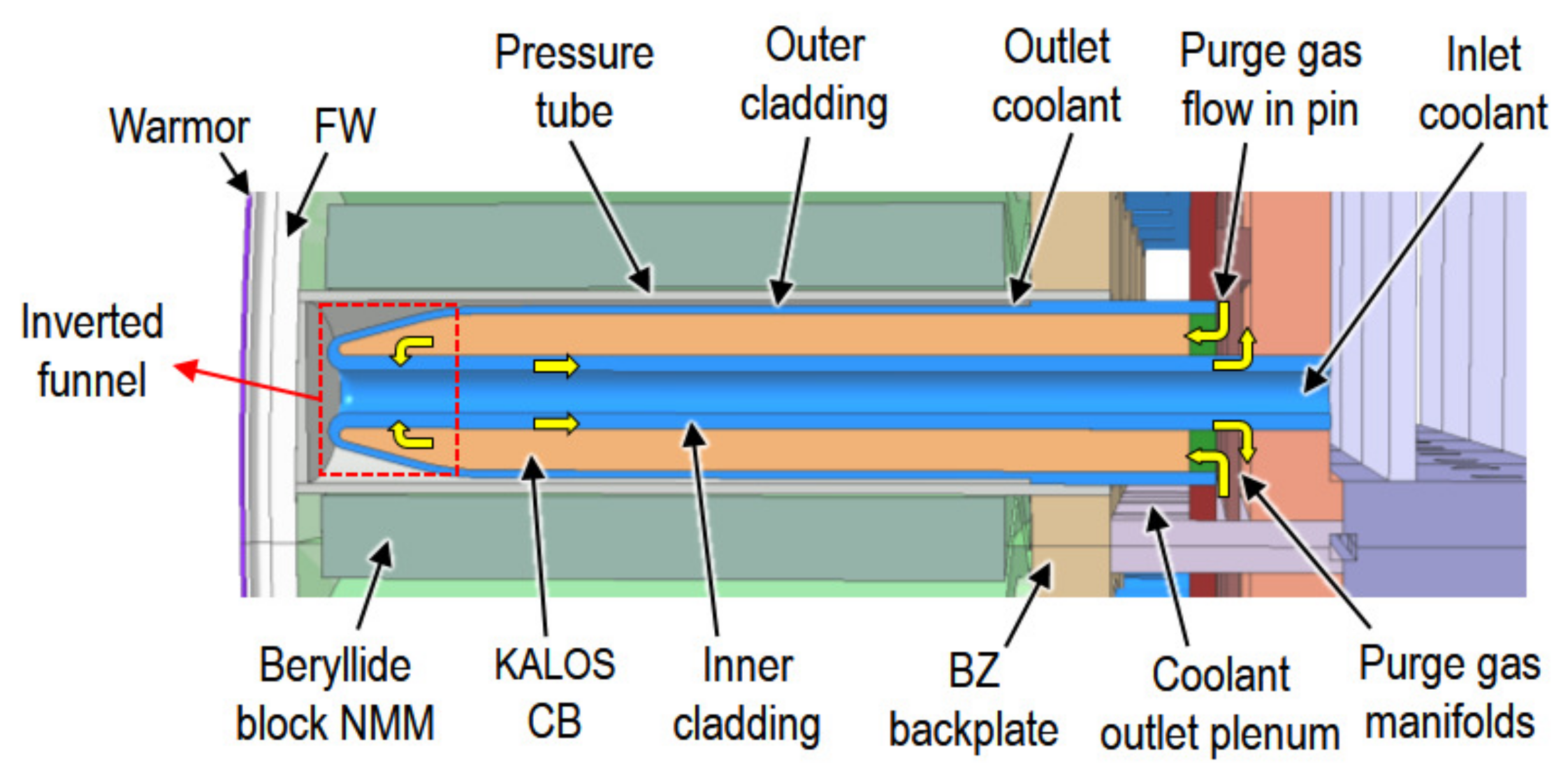


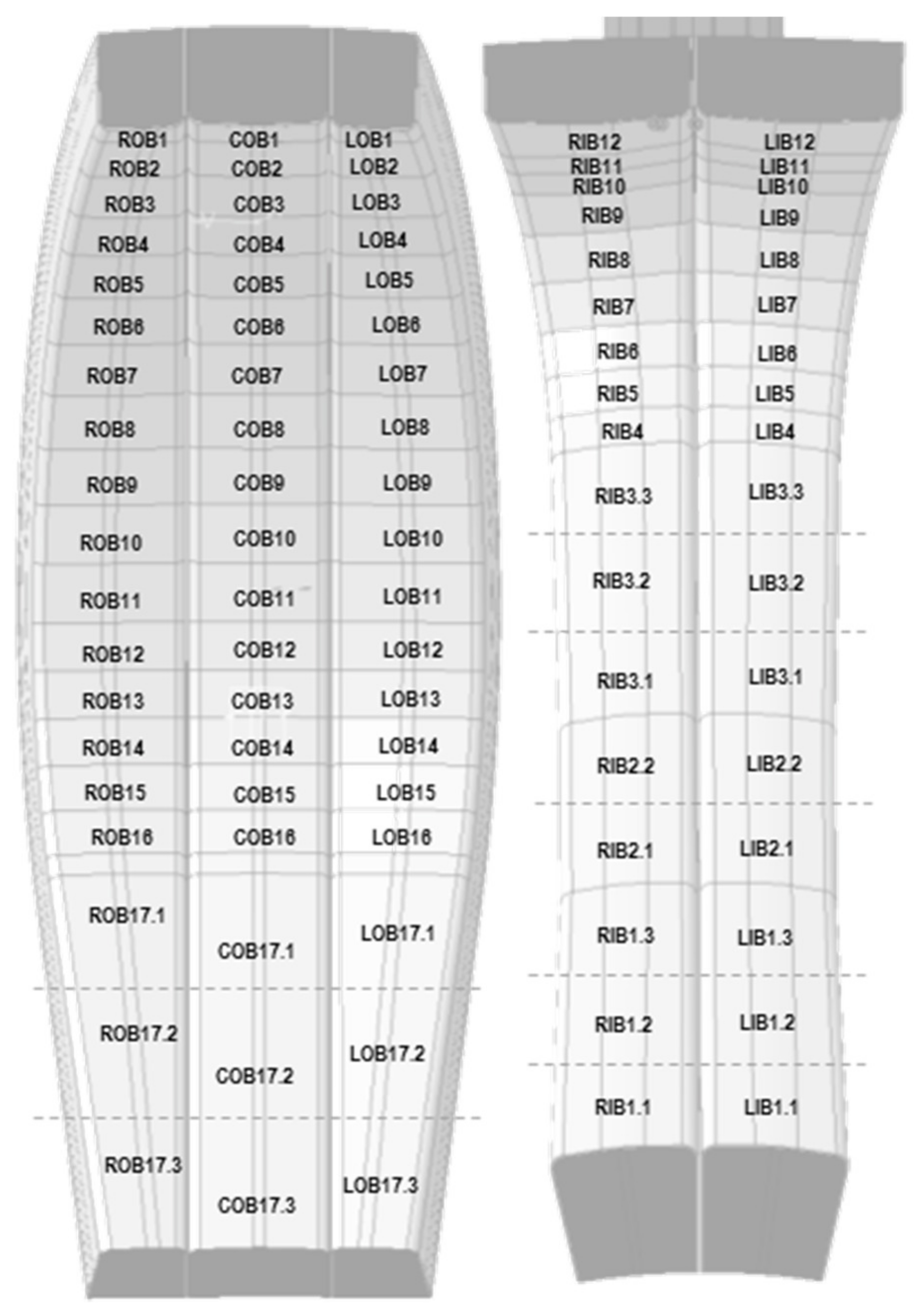

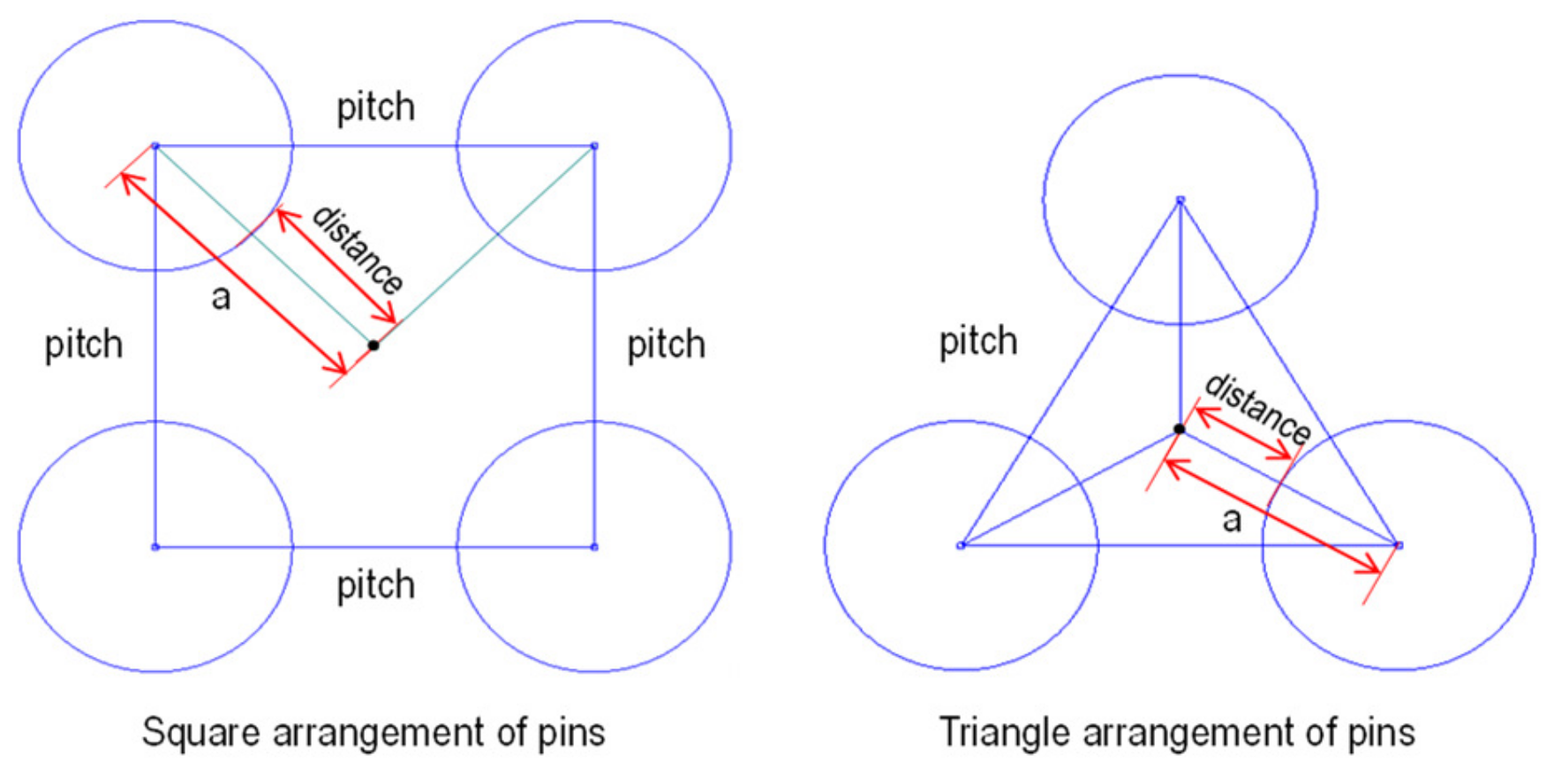

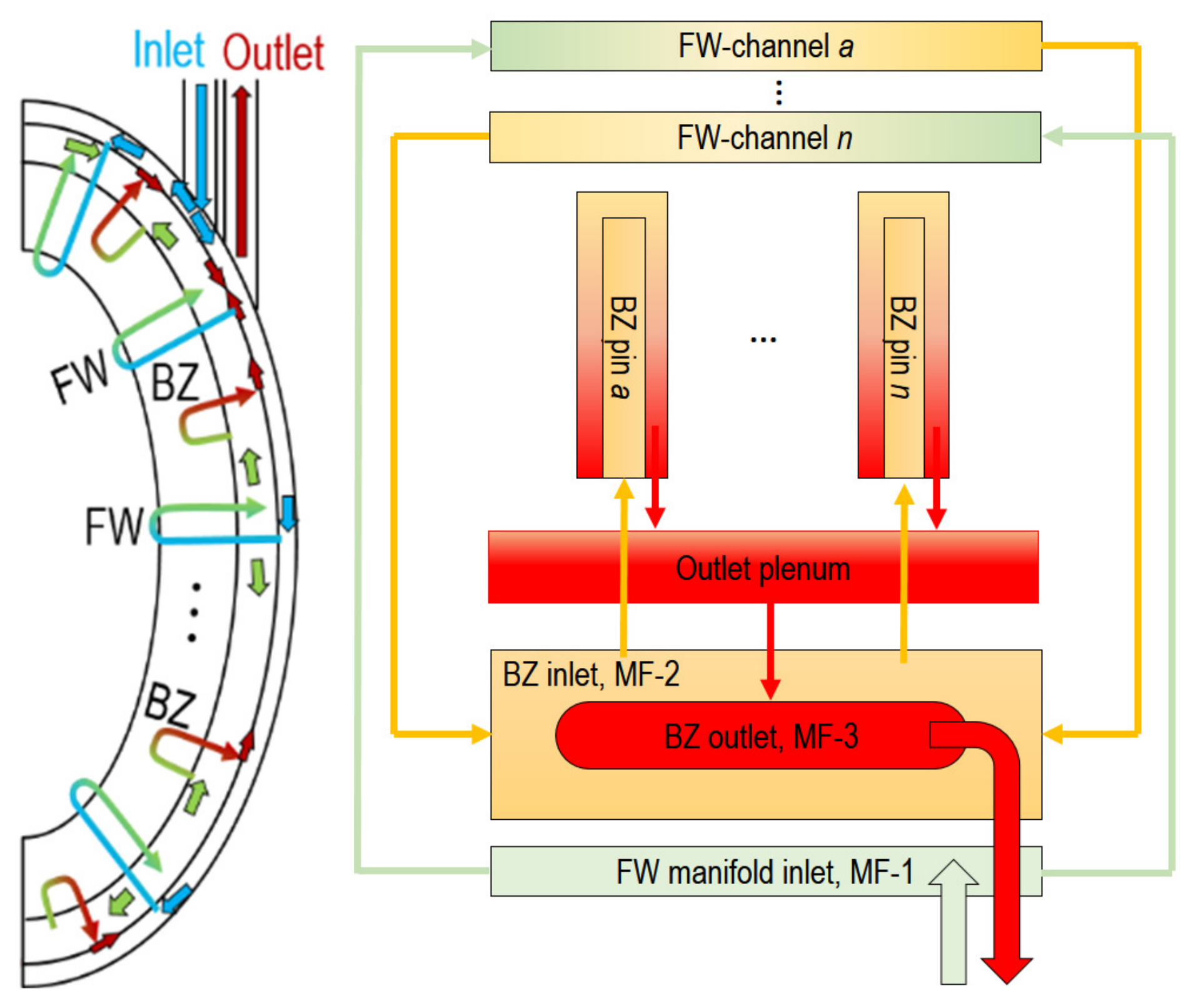


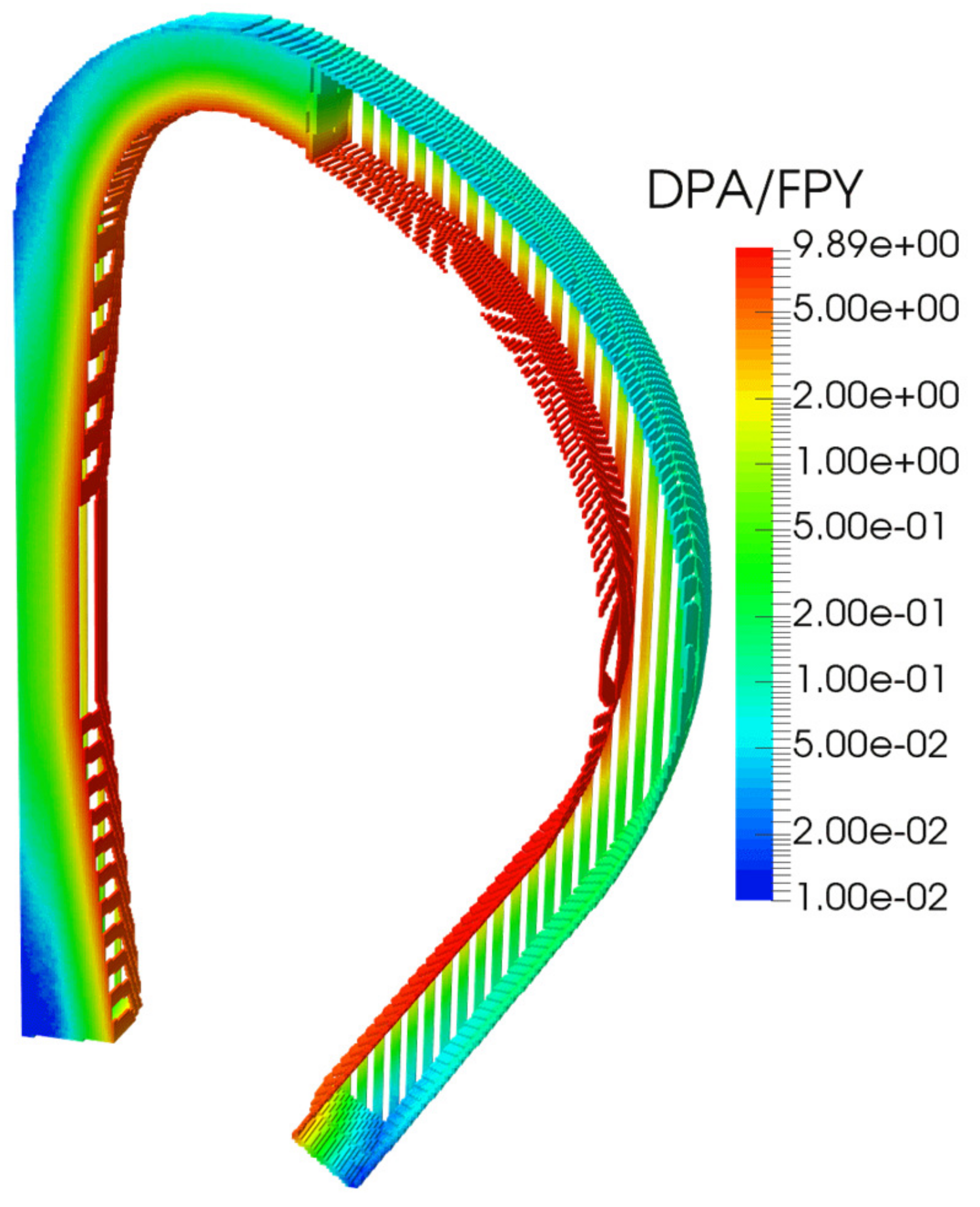


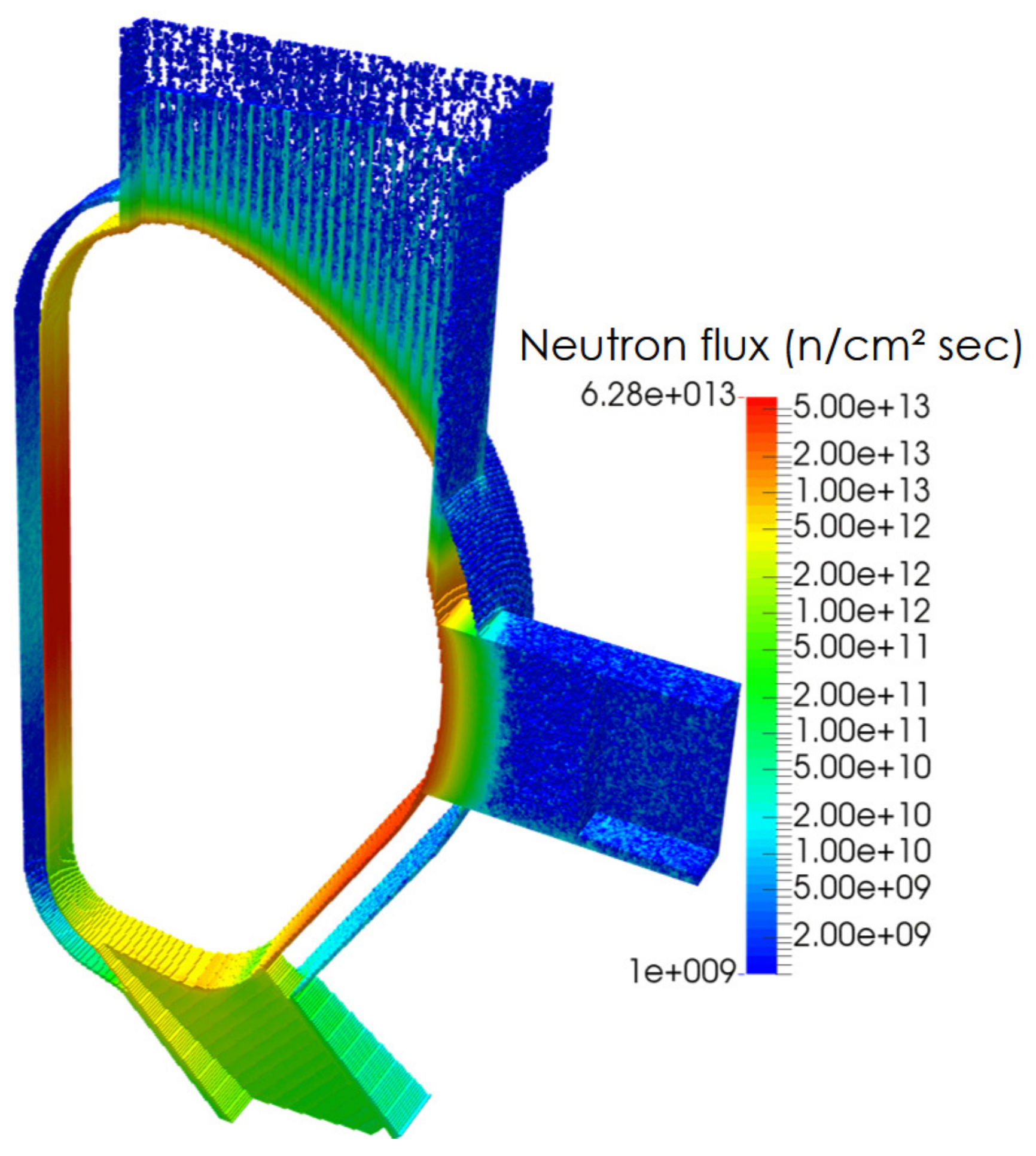
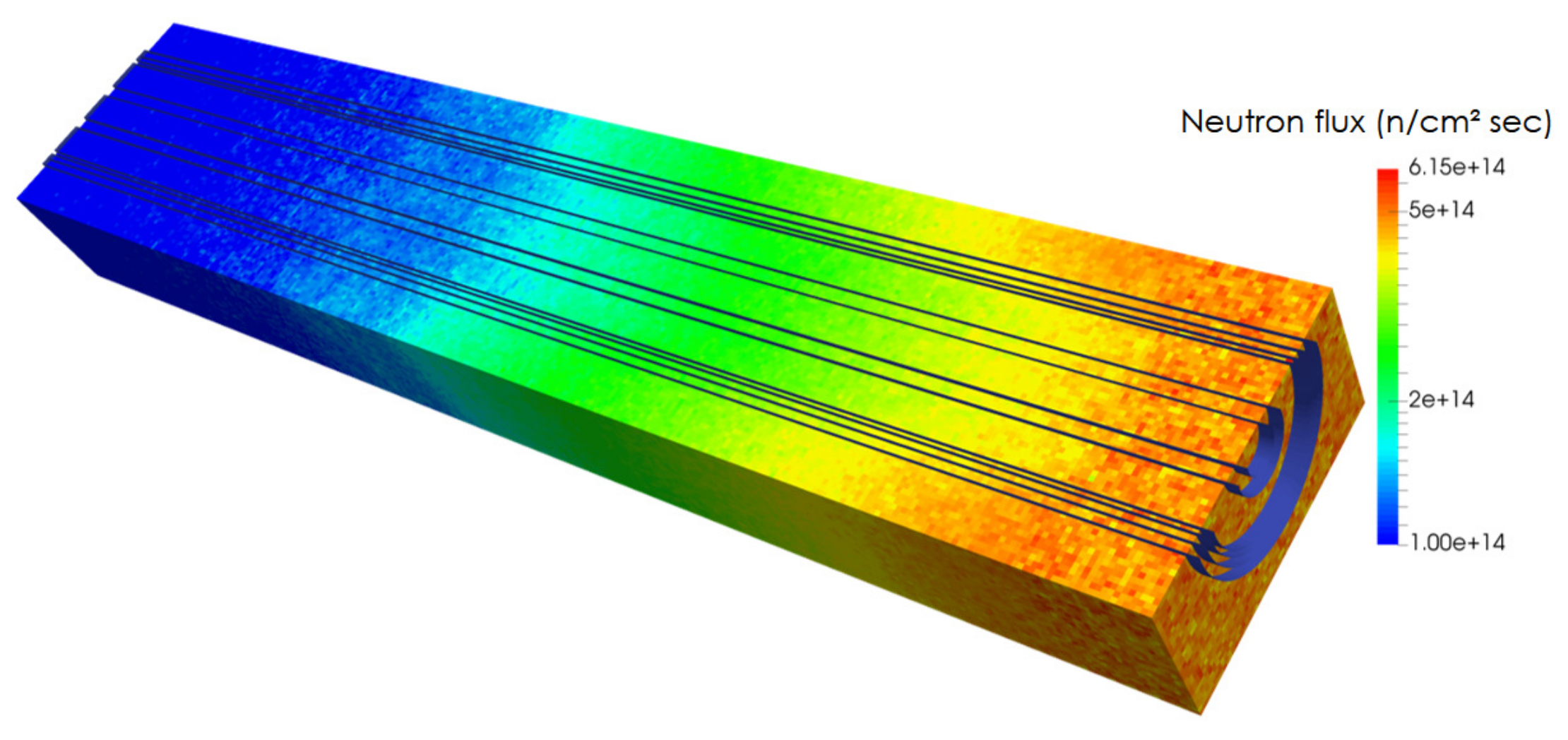
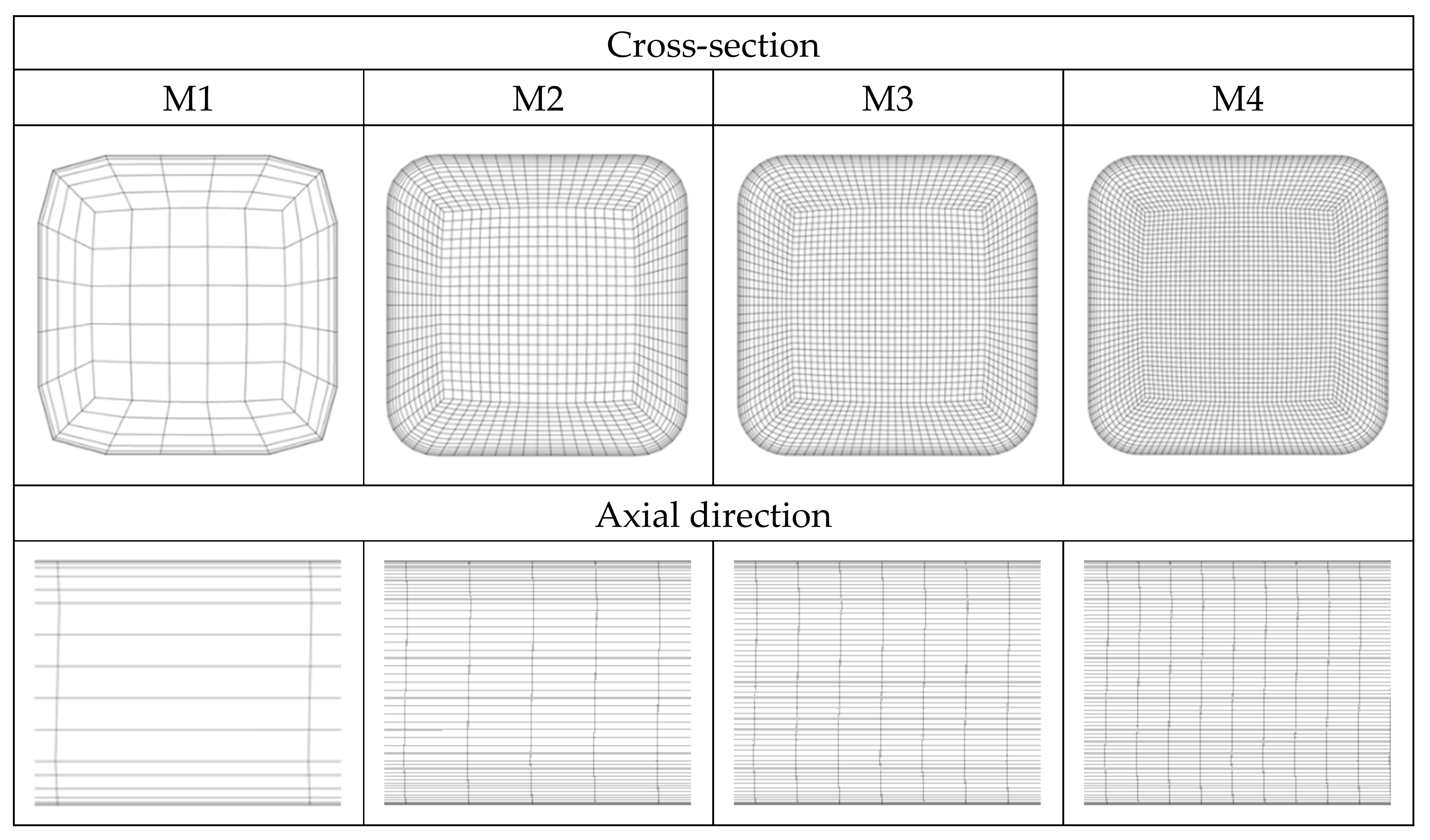

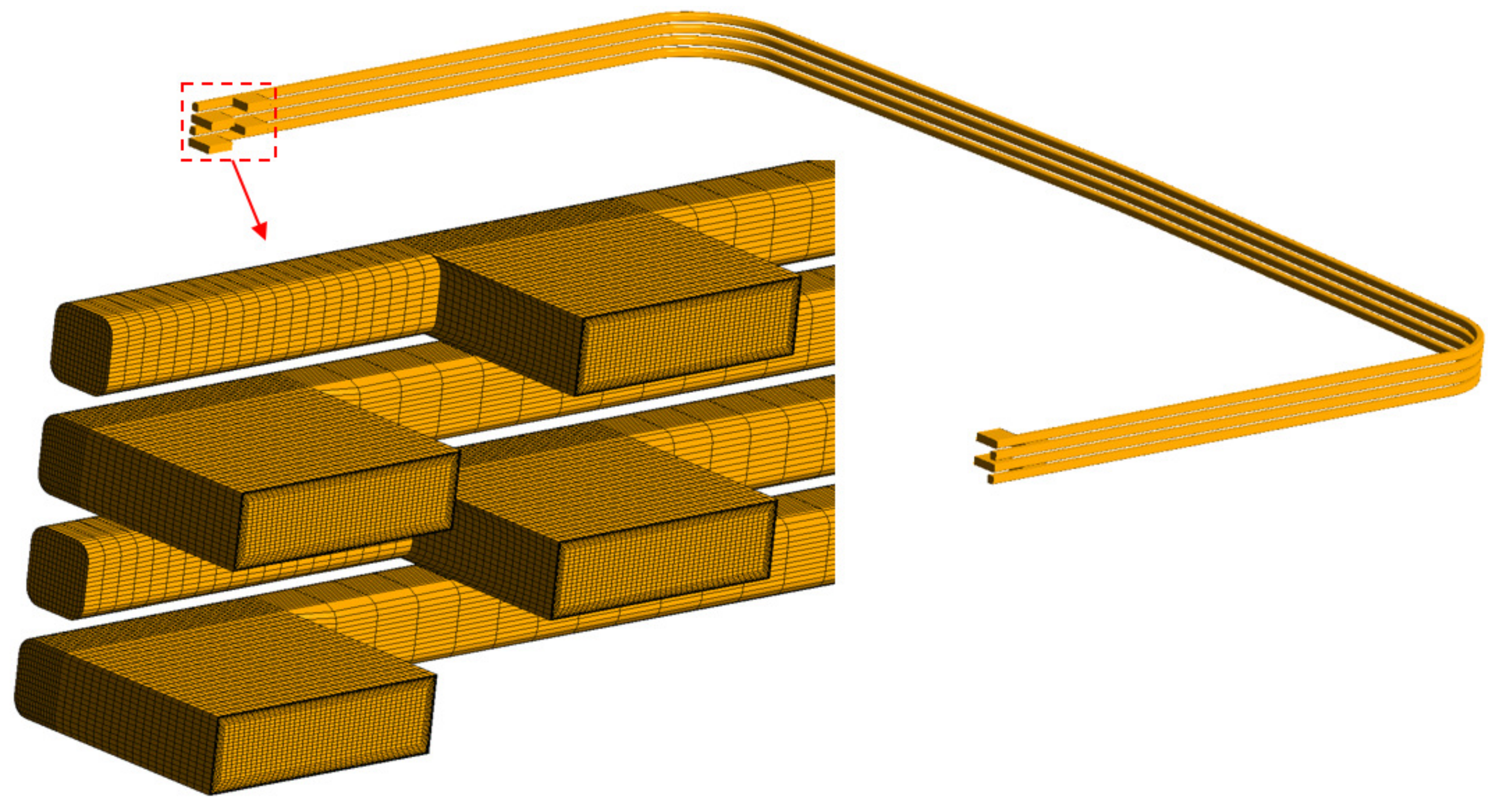





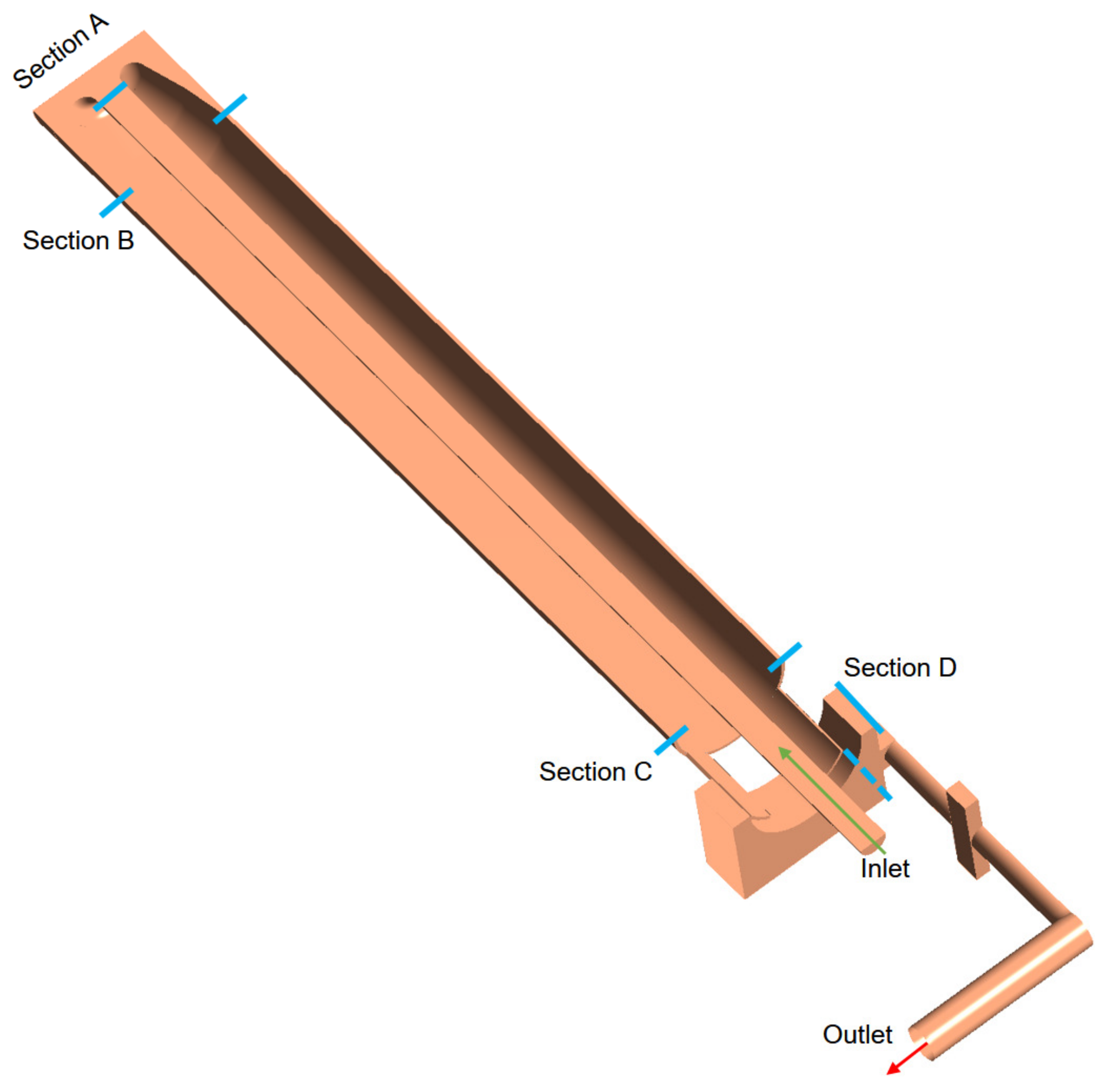
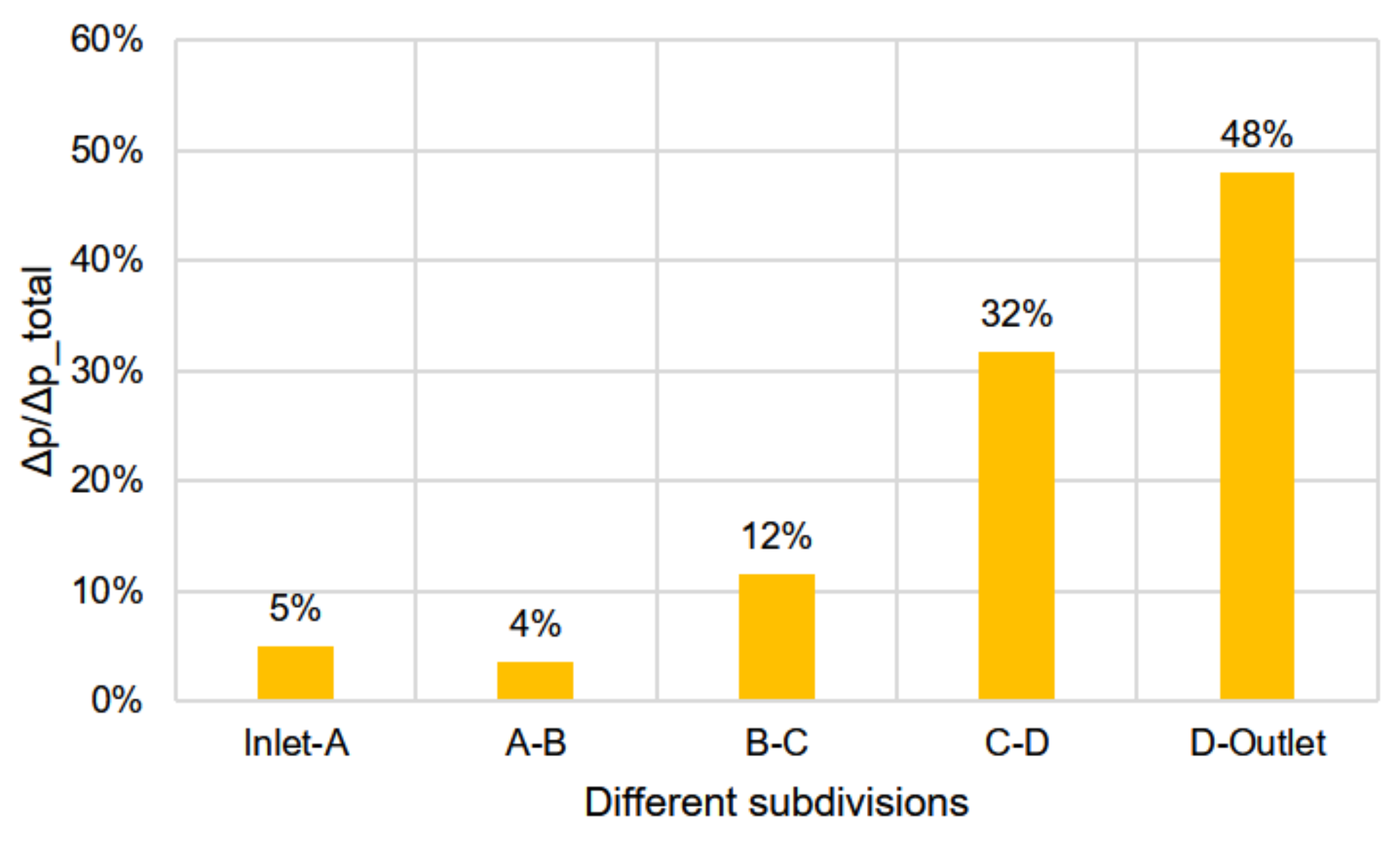
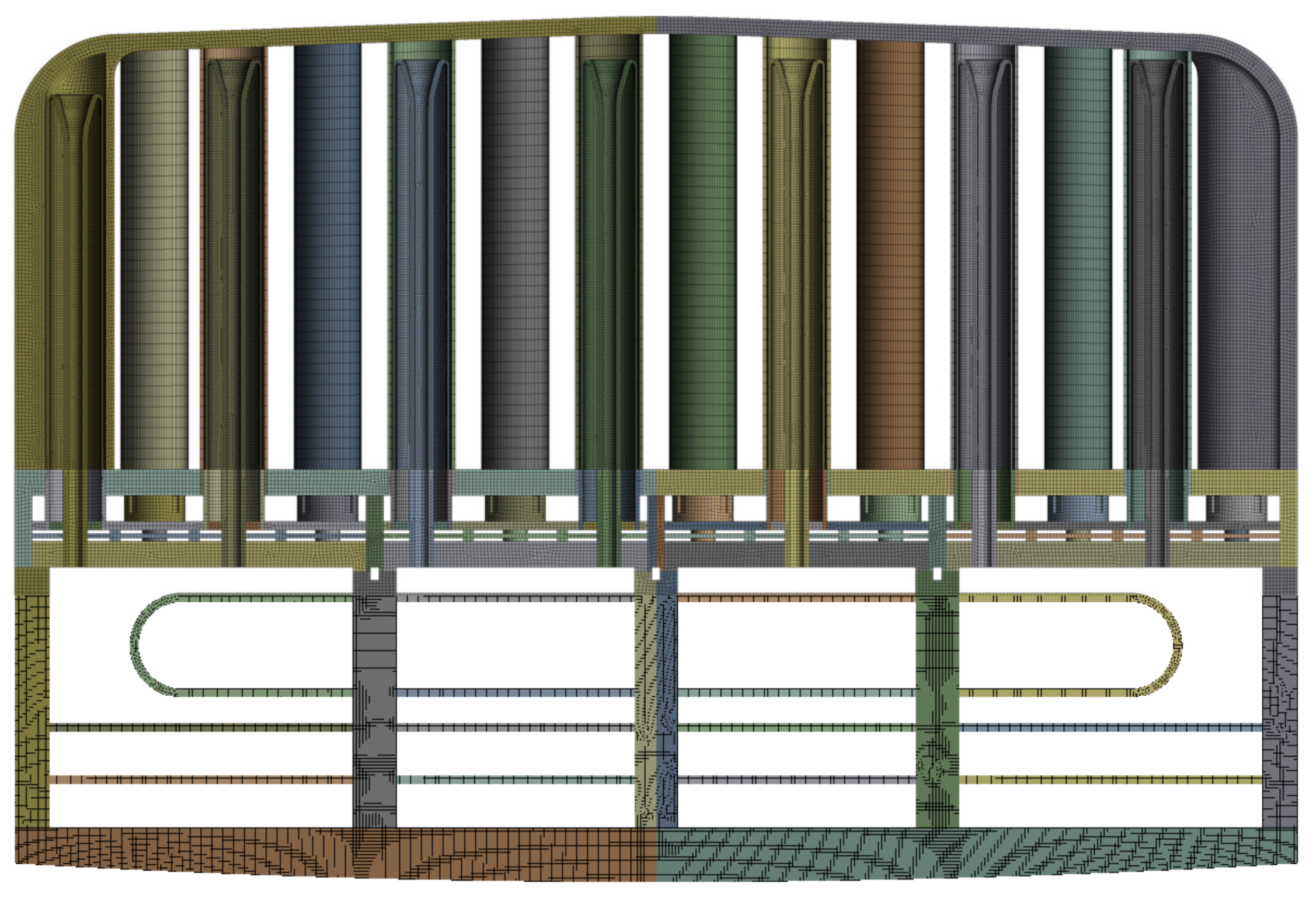
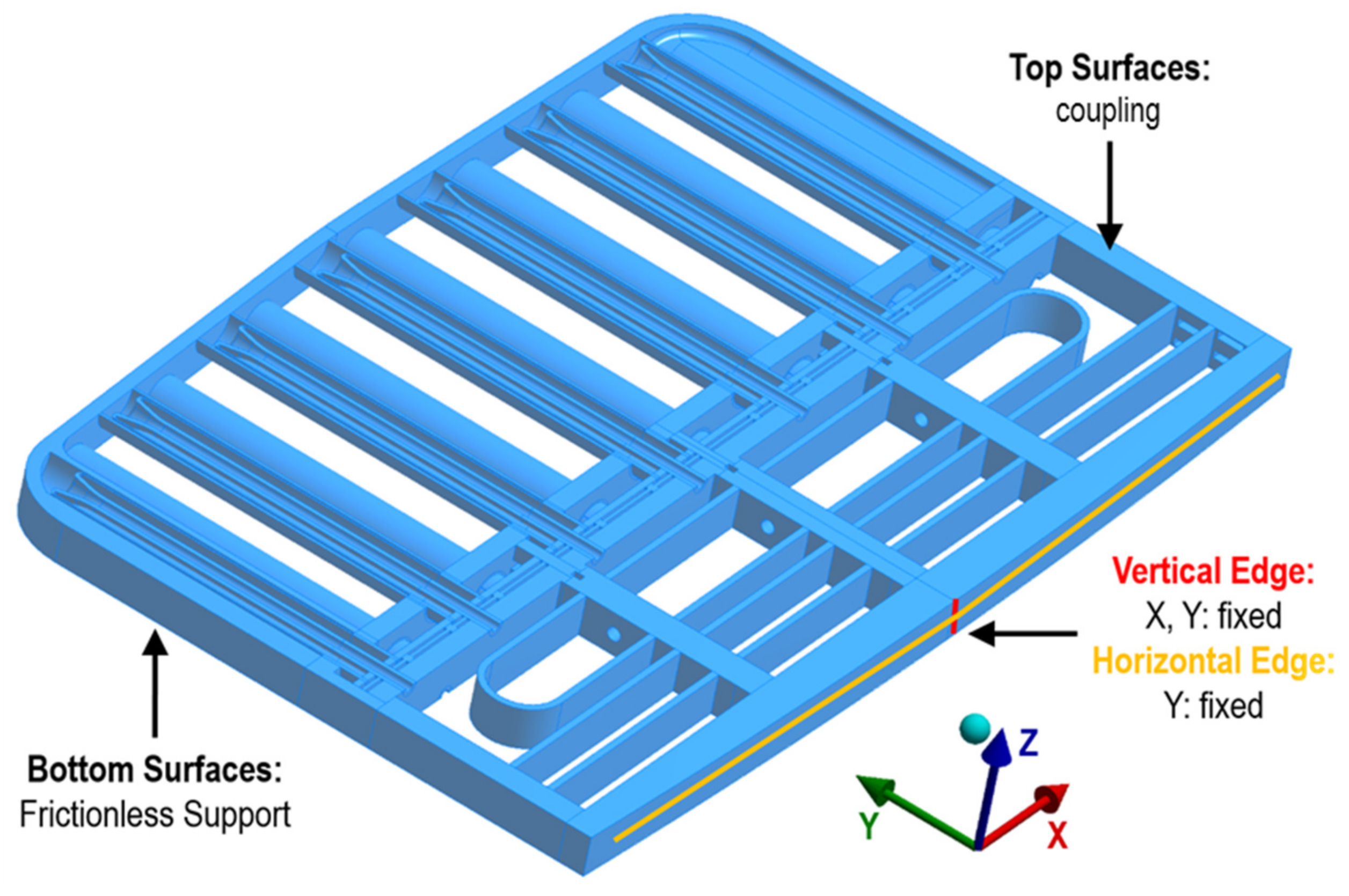
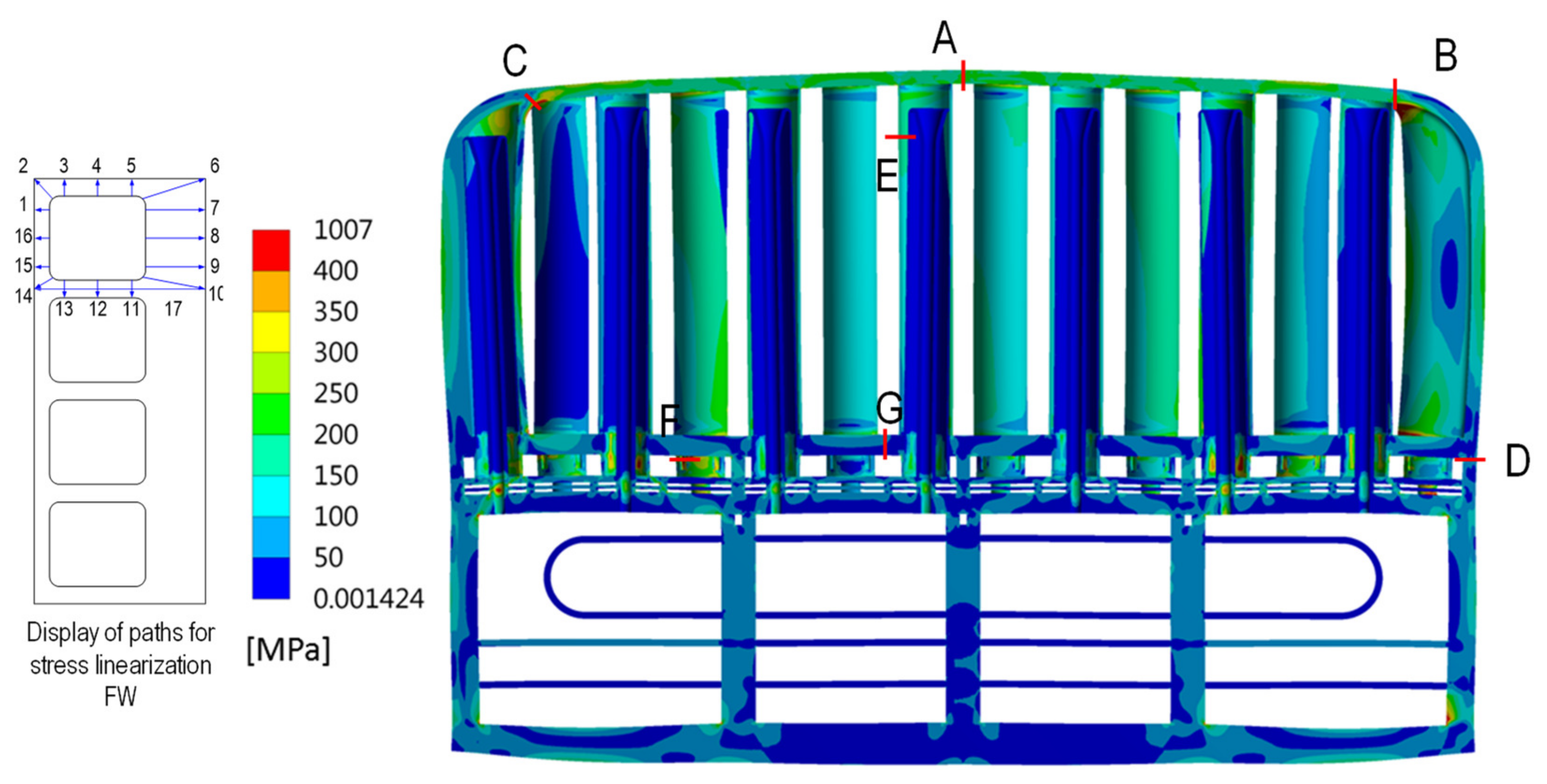
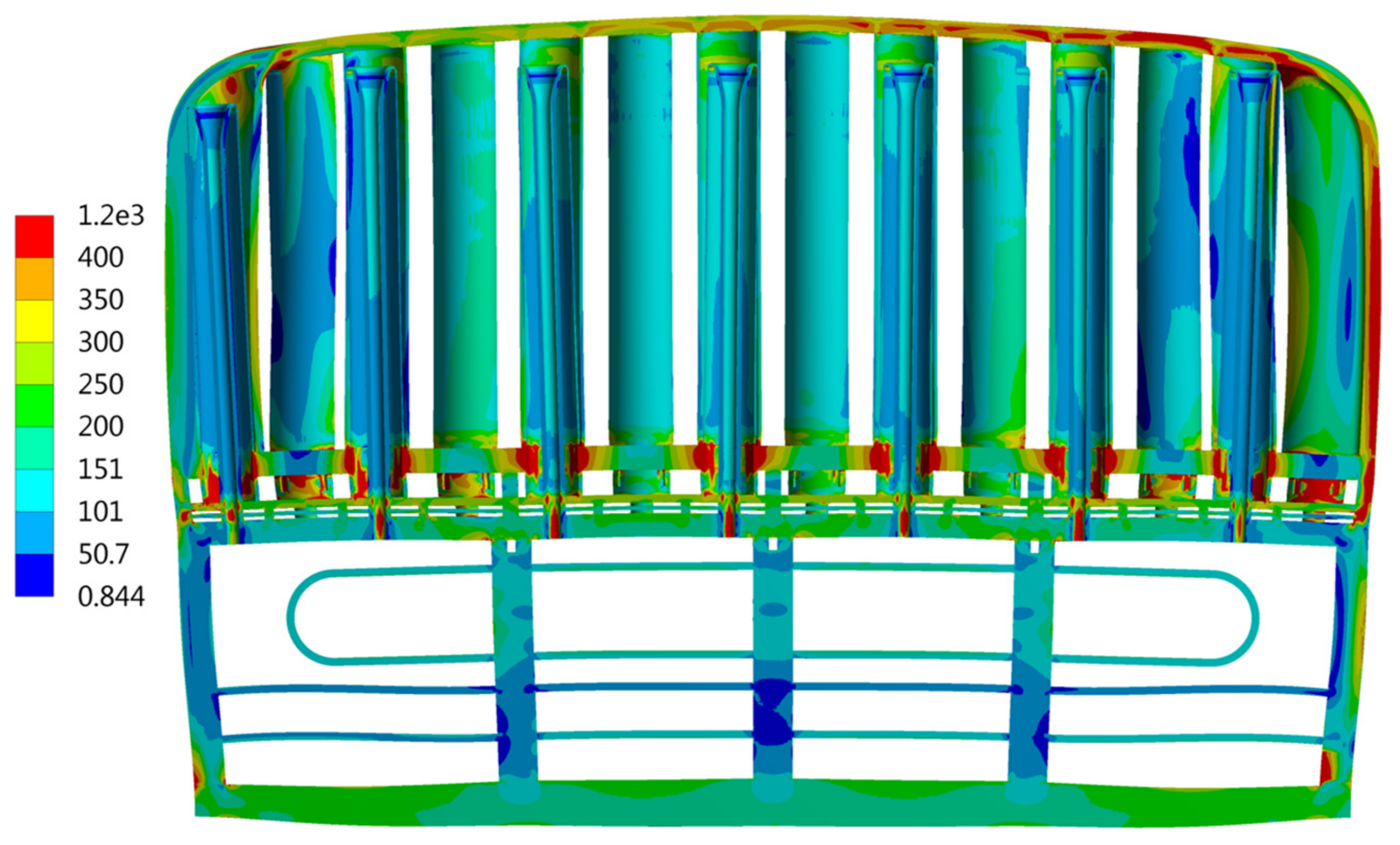



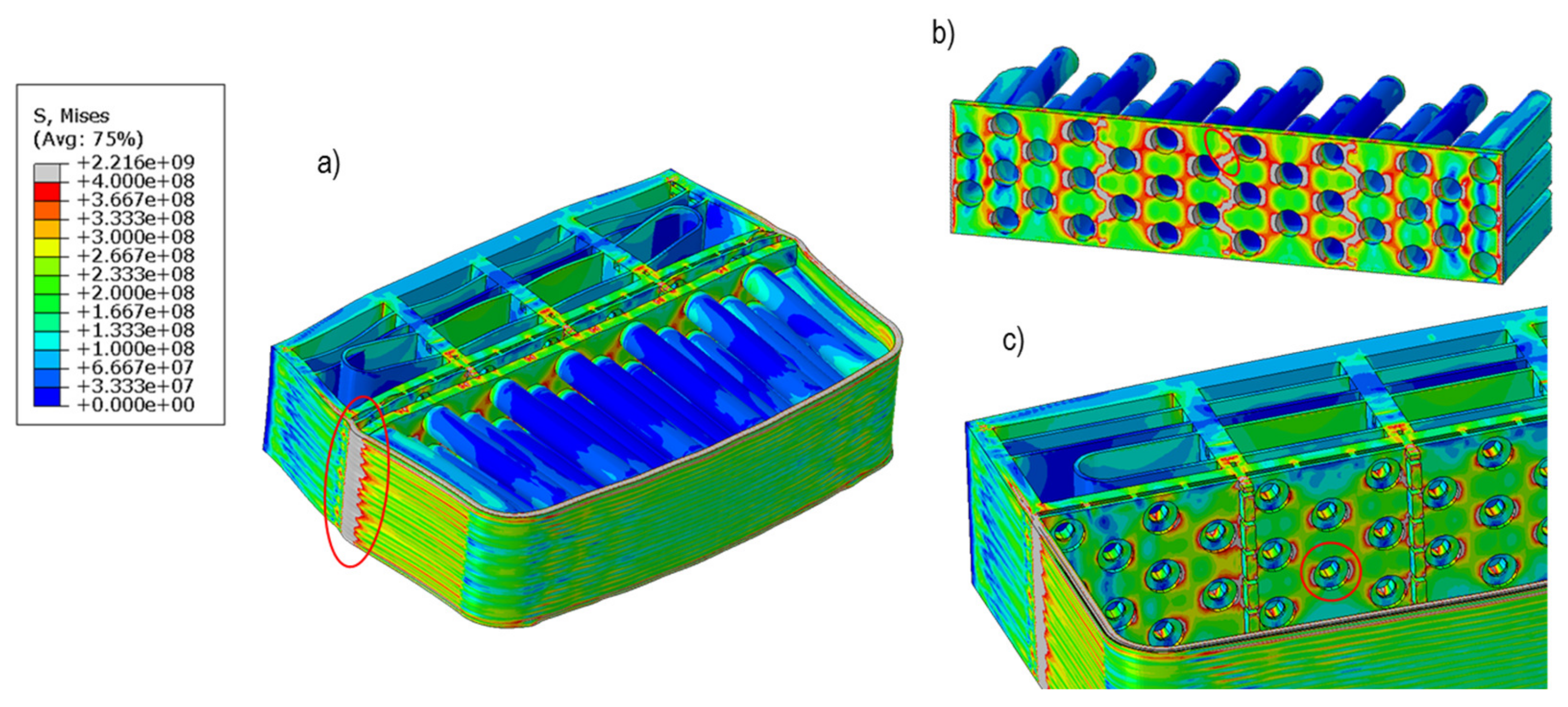
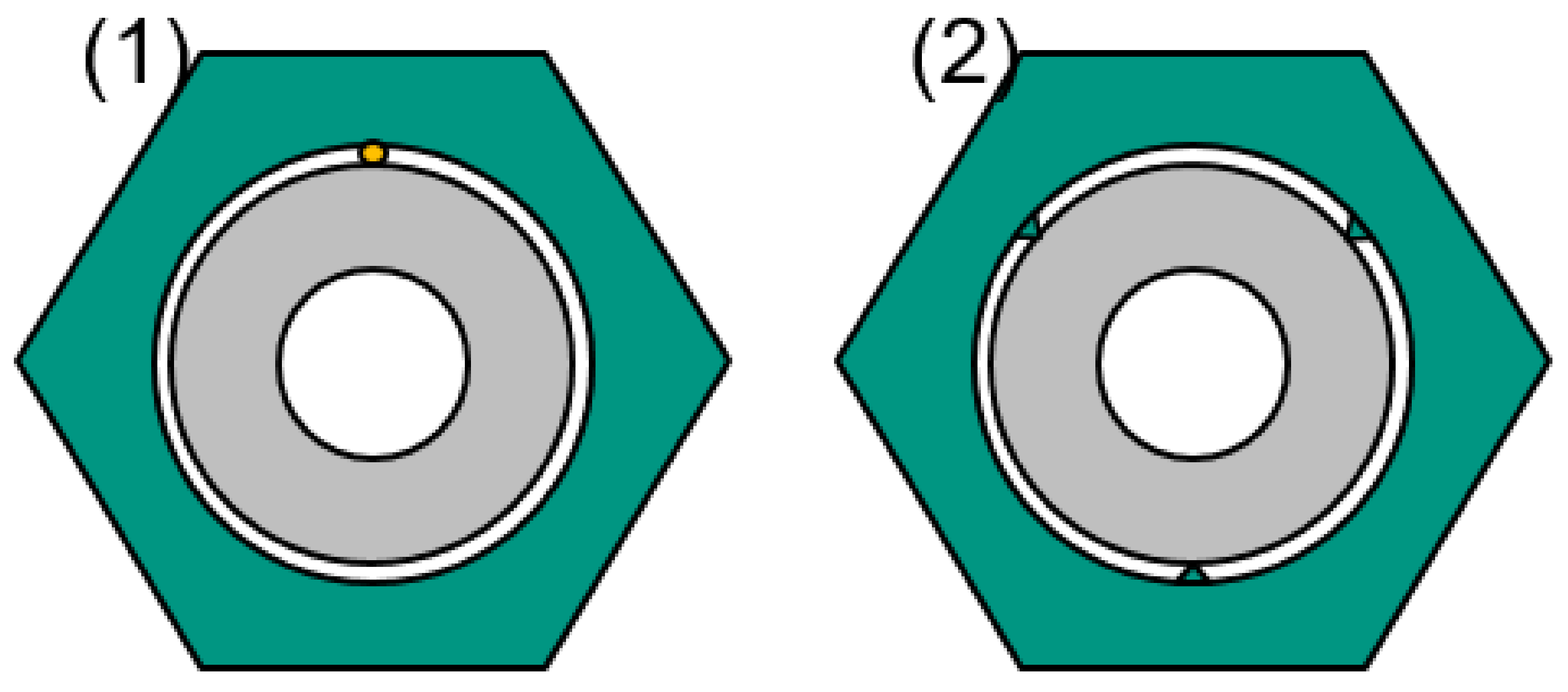
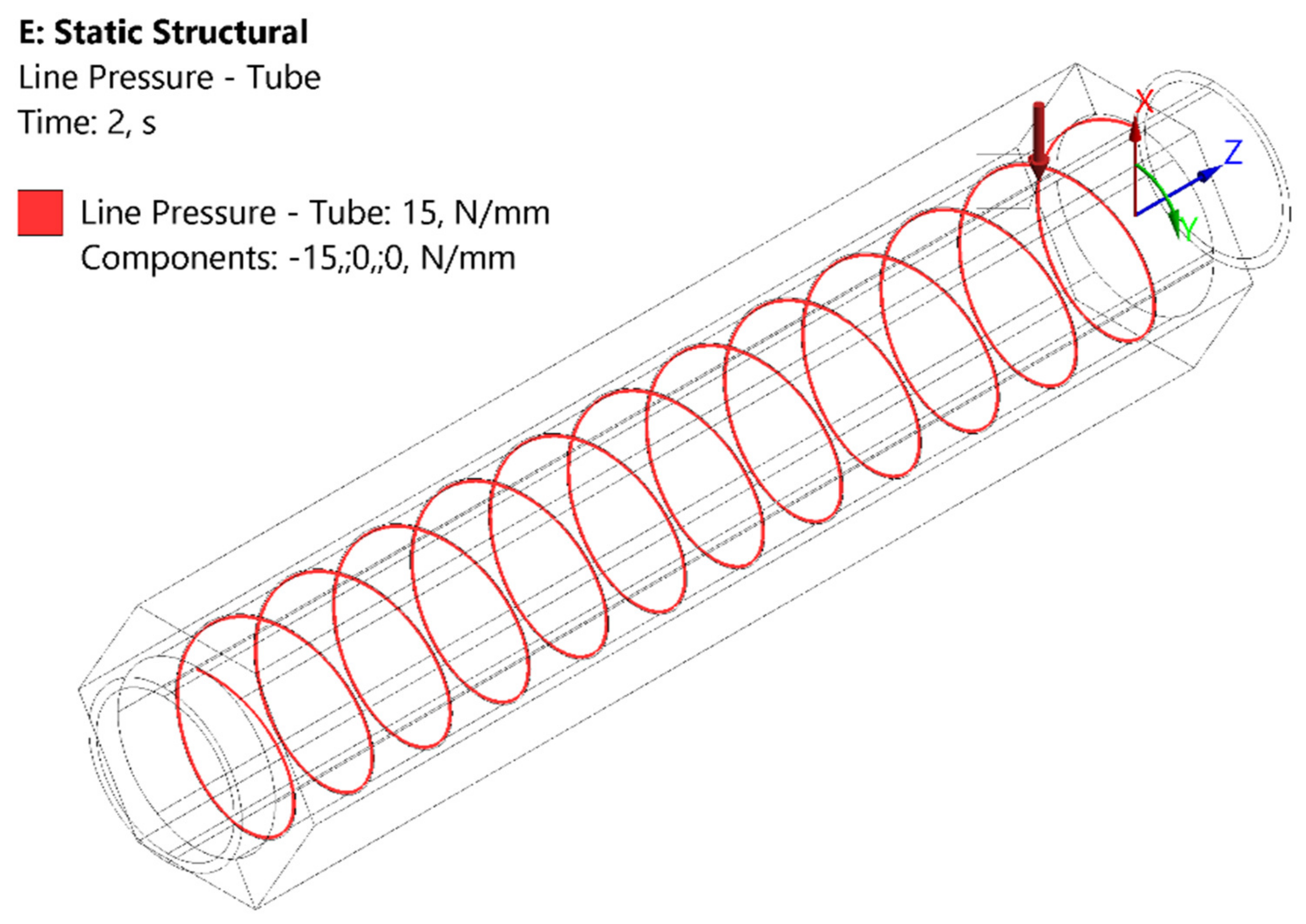

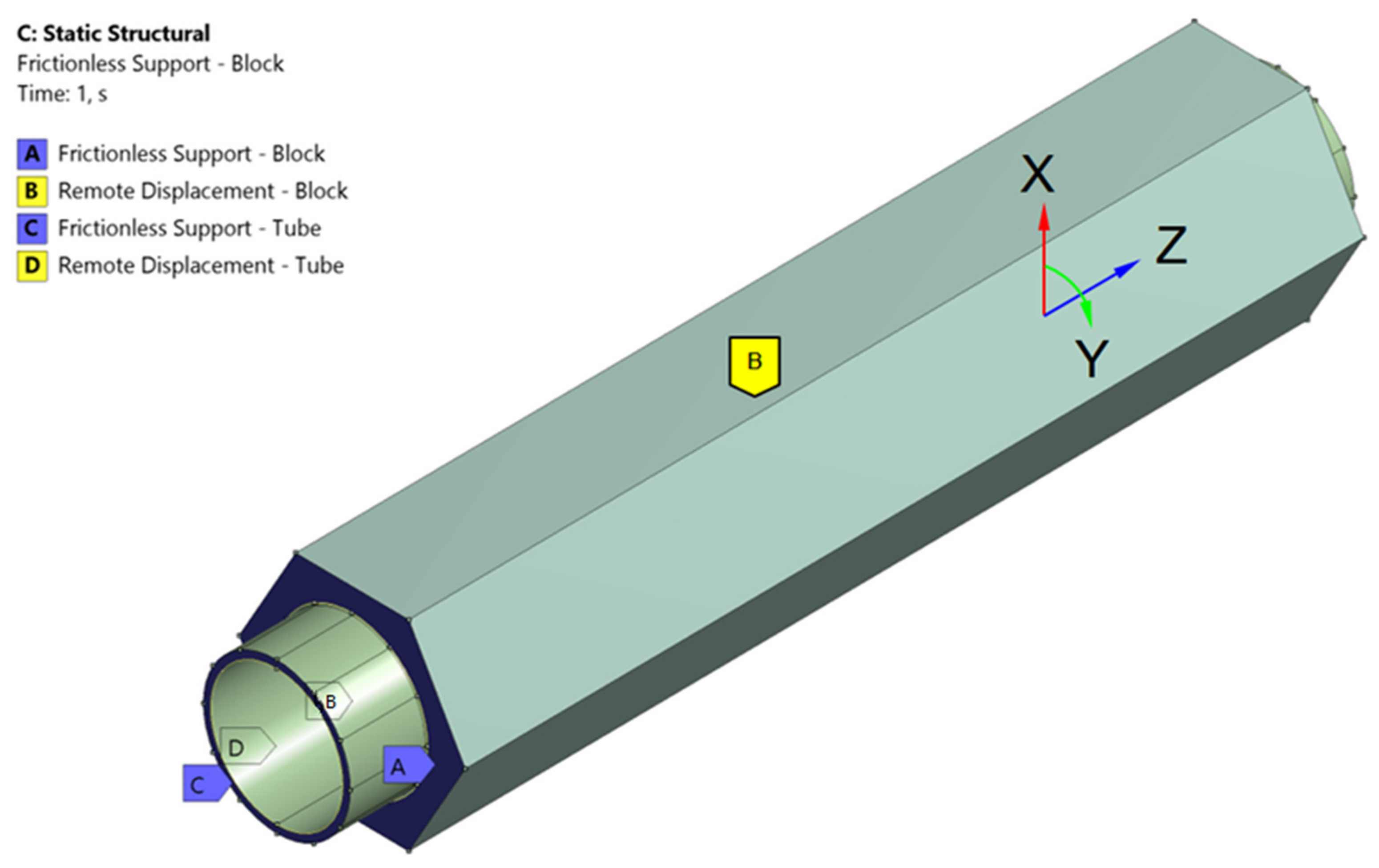

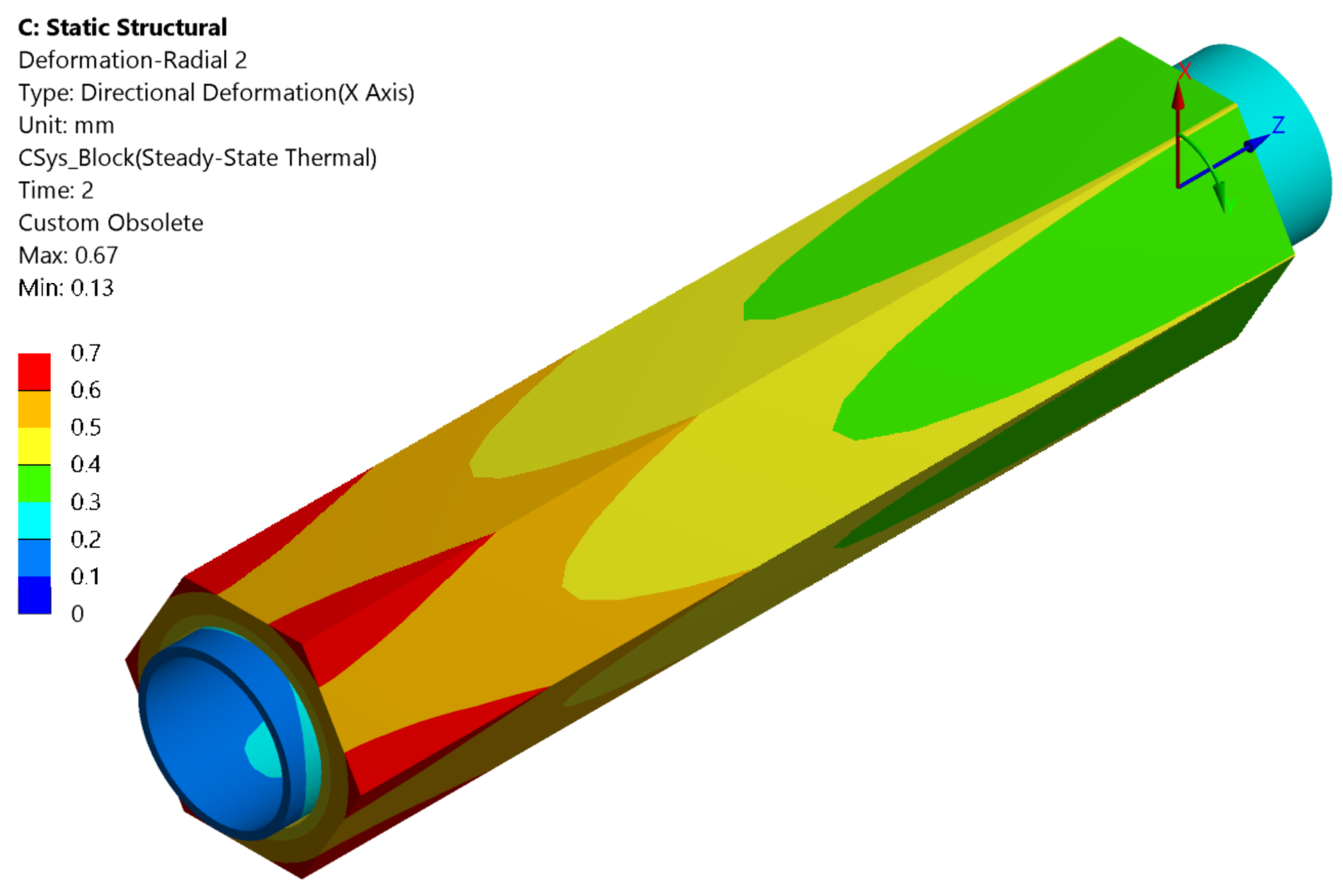




| BB Region | FW Height (Poloidal) | FW Width (Toroidal) | FW Side Wall Length (Radial) |
|---|---|---|---|
| (mm) | (mm) | (mm) | |
| R/LOB1 | 531 | 947 | 485 |
| R/LOB2 | 750 | 1046 | 478 |
| R/LOB3 | 750 | 1170 | 474 |
| R/LOB4 | 625 | 1270 | 474 |
| R/LOB5 | 625 | 1355 | 488 |
| R/LOB6 | 625 | 1331 | 495 |
| R/LOB7 | 625 | 1494 | 505 |
| R/LOB8 | 625 | 1547 | 508 |
| R/LOB9 | 625 | 1585 | 510 |
| R/LOB10 | 625 | 1611 | 510 |
| R/LOB11 | 625 | 1624 | 502 |
| R/LOB12 | 500 | 1624 | 489 |
| R/LOB13 | 500 | 1612 | 461 |
| R/LOB14 | 500 | 1578 | 436 |
| R/LOB15 | 500 | 1552 | 416 |
| R/LOB16 | 500 | 1507 | 400 |
| R/LOB17.1 | 1528 | 1406 | 423 |
| R/LOB17.2 | 1528 | 1204 | 464 |
| R/LOB17.3 | 1528 | 1018 | 505 |
| BB Region | FW Height (Poloidal) | FW Width (Toroidal) | FW Side Wall Length (Radial) |
|---|---|---|---|
| (mm) | (mm) | (mm) | |
| R/LIB12 | 1406 | 1140 | 658 |
| R/LIB11 | 1406 | 1140 | 497 |
| R/LIB10 | 1406 | 1140 | 352 |
| R/LIB9 | 1151 | 1095 | 291 |
| R/LIB8 | 1151 | 1095 | 291 |
| R/LIB7 | 1125 | 1117 | 322 |
| R/LIB6 | 1125 | 1117 | 415 |
| R/LIB5 | 1125 | 1117 | 482 |
| R/LIB4 | 375 | 1150 | 532 |
| R/LIB3.3 | 375 | 1172 | 573 |
| R/LIB3.2 | 375 | 1210 | 519 |
| R/LIB3.1 | 375 | 1263 | 498 |
| R/LIB2.2 | 375 | 1335 | 466 |
| R/LIB2.1 | 375 | 1414 | 464 |
| R/LIB1.3 | 250 | 1475 | 478 |
| R/LIB1.2 | 250 | 1536 | 488 |
| R/LIB1.1 | 531 | 1614 | 494 |
| BB Region | Width (pol.) | Height (rad.) | BB Region | Width (pol.) | Height (rad.) | BB Region | Width (pol.) | Height (rad.) |
|---|---|---|---|---|---|---|---|---|
| (mm) | (mm) | (mm) | (mm) | (mm) | (mm) | |||
| R/LOB1 | 12 | 14 | COB1 | 12 | 12 | R/LIB12 | 12 | 12 |
| R/LOB2 | 12 | 11 | COB2 | 12 | 12 | R/LIB11 | 12 | 12 |
| R/LOB3 | 12 | 11 | COB3 | 12 | 12 | R/LIB10 | 15 | 15 |
| R/LOB4 | 12 | 11 | COB4 | 12 | 12 | R/LIB9 | 15 | 15 |
| R/LOB5 | 12 | 12 | COB5 | 12 | 12 | R/LIB8 | 15 | 15 |
| R/LOB6 | 12 | 12 | COB6 | 12 | 12 | R/LIB7 | 10 | 8 |
| R/LOB7 | 12 | 12 | COB7 | 12 | 12 | R/LIB6 | 10 | 8 |
| R/LOB8 | 12 | 12 | COB8 | 12 | 12 | R/LIB5 | 10 | 8 |
| R/LOB9 | 12 | 12 | COB9 | 12 | 12 | R/LIB4 | 10 | 8 |
| R/LOB10 | 12 | 12 | COB10 | 12 | 12 | R/LIB3.3 | 10 | 8 |
| R/LOB11 | 12 | 12 | COB11 | 12 | 12 | R/LIB3.2 | 10 | 8 |
| R/LOB12 | 12 | 12 | COB12 | 12 | 12 | R/LIB3.1 | 10 | 8 |
| R/LOB13 | 12 | 12 | COB13 | 12 | 12 | R/LIB2.2 | 10 | 8 |
| R/LOB14 | 12 | 12 | COB14 | 12 | 12 | R/LIB2.1 | 10 | 8 |
| R/LOB15 | 12 | 12 | COB15 | 12 | 12 | R/LIB1.3 | 10 | 8 |
| R/LOB16 | 12 | 12 | COB16 | 12 | 12 | R/LIB1.2 | 10 | 8 |
| R/LOB17.1 | 12 | 12 | COB17.1 | 13 | 13 | R/LIB1.1 | 10 | 8 |
| R/LOB17.2 | 12 | 11 | COB17.2 | 13 | 13 | |||
| R/LOB17.3 | 12 | 11 | COB17.3 | 13 | 13 |
| M1 | M2 | M3 | M4 | |
|---|---|---|---|---|
| Mesh nodes | 37,944 | 1,603,119 | 4,054,018 | 8,003,677 |
| Mesh elements | 35,060 | 1,560,800 | 3,960,900 | 7,840,000 |
| Number of Mesh Nodes | Pressure Drop (Pa) | Difference from M5 (%) | |
|---|---|---|---|
| M1 | 37,944 | 37,740 | −4.259 |
| M2 | 1,603,119 | 36,020 | 0.493 |
| M3 | 4,054,018 | 36,112 | 0.24 |
| M4 | 8,003,677 | 36,199 | 0 |
| IPI | IPFL | ||||||
|---|---|---|---|---|---|---|---|
| Path | Path Average Temp. | Linearized Stress Value | Stress Limit | Φ | Linearized Stress Value | Stress Limit | Φ |
| A1 | 480.0 | 210.8 | 286.2 | 50.9% | 321.0 | 455.0 | 29% |
| A2 | 480.8 | 205.3 | 285.7 | 52.1% | 317.8 | 453.1 | 30% |
| A3 | 476.3 | 200.2 | 288.3 | 53.7% | 329.8 | 463.8 | 29% |
| A4 | 448.0 | 221.8 | 304.8 | 51.5% | 384.0 | 529.9 | 28% |
| A5 | 431.6 | 215.9 | 312.6 | 53.9% | 400.6 | 559.4 | 28% |
| A6 | 431.7 | 230.6 | 312.5 | 50.8% | 363.7 | 559.2 | 35% |
| A7 | 455.8 | 217.7 | 300.4 | 51.7% | 366.3 | 512.5 | 29% |
| A8 | 456.7 | 221.6 | 299.9 | 50.7% | 361.1 | 510.3 | 29% |
| A9 | 457.3 | 216.7 | 299.5 | 51.8% | 358.5 | 508.9 | 30% |
| A10 | 458.2 | 212.5 | 299.0 | 52.6% | 353.6 | 506.8 | 30% |
| A11 | 459.5 | 214.8 | 298.2 | 52.0% | 377.1 | 503.7 | 25% |
| A12 | 438.1 | 212.6 | 309.5 | 54.2% | 374.9 | 547.7 | 32% |
| A13 | 437.3 | 212.8 | 309.8 | 54.2% | 312.4 | 549.1 | 43% |
| A14 | 451.9 | 200.1 | 302.7 | 55.9% | 304.5 | 521.7 | 42% |
| A15 | 479.4 | 206.9 | 286.5 | 51.9% | 318.7 | 456.4 | 30% |
| A16 | 481.5 | 213.6 | 285.3 | 50.1% | 315.2 | 451.4 | 30% |
| A17 | 456.9 | 216.4 | 299.7 | 51.9% | 339.6 | 509.9 | 33% |
| Coolant | Density | Cp | Dynamic Viscosity | Thermal Conductivity |
|---|---|---|---|---|
| kg/m3 | J/kg∗K | Pa∗s | W/m∗K | |
| He | 5.6376 | 5188.7 | 3.50 × 10−5 | 0.27759 |
| CO2 | 63.09 | 1159.6 | 3.15 × 10−5 | 0.049073 |
Disclaimer/Publisher’s Note: The statements, opinions and data contained in all publications are solely those of the individual author(s) and contributor(s) and not of MDPI and/or the editor(s). MDPI and/or the editor(s) disclaim responsibility for any injury to people or property resulting from any ideas, methods, instructions or products referred to in the content. |
© 2023 by the authors. Licensee MDPI, Basel, Switzerland. This article is an open access article distributed under the terms and conditions of the Creative Commons Attribution (CC BY) license (https://creativecommons.org/licenses/by/4.0/).
Share and Cite
Zhou, G.; Hernández, F.A.; Pereslavtsev, P.; Kiss, B.; Retheesh, A.; Maqueda, L.; Park, J.H. The European DEMO Helium Cooled Pebble Bed Breeding Blanket: Design Status at the Conclusion of the Pre-Concept Design Phase. Energies 2023, 16, 5377. https://doi.org/10.3390/en16145377
Zhou G, Hernández FA, Pereslavtsev P, Kiss B, Retheesh A, Maqueda L, Park JH. The European DEMO Helium Cooled Pebble Bed Breeding Blanket: Design Status at the Conclusion of the Pre-Concept Design Phase. Energies. 2023; 16(14):5377. https://doi.org/10.3390/en16145377
Chicago/Turabian StyleZhou, Guangming, Francisco A. Hernández, Pavel Pereslavtsev, Béla Kiss, Anoop Retheesh, Luis Maqueda, and Jin Hun Park. 2023. "The European DEMO Helium Cooled Pebble Bed Breeding Blanket: Design Status at the Conclusion of the Pre-Concept Design Phase" Energies 16, no. 14: 5377. https://doi.org/10.3390/en16145377






